| |

Home
Thousands of tastings,
all the music,
all the rambligs
and all the fun
(hopefully!)



Whiskyfun.com
Guaranteed ad-free
copyright 2002-2023
|
 |
|
| Hi, this is one of our (almost) daily tastings. Santé! |
| |
|
| |
| |
January 1, 2023 |
|
  |
Celebrating the New Year with Hampden |

|
|
A word of caution
Let me please remind you that my humble assessments of any spirits are done from the point of view of a malt whisky enthusiast who, what's more, is aboslutely not an expert in rum, brandy, tequila, vodka, gin or any other spirits. Thank you – and peace! |
Did you know that Hampden was founded by a Scotsman called Archibald Sterling? And that they were in big trouble until the Jamaican government stepped in in the beginning of this century and then sold it on in the year 2009? Anyway, we never taste only rums from the same Distillery within one single session, as rum remains a 'side spirit' at Whiskyfun, but today we shall make an exception since: |
- This is January 1st,
- It's going to be Hampden indeed,
- There is an incredible new official set of 8 different marks/marques, all in nifty 20cl bottles,
- What's more, they're all white, so obviously fully distillate-driven and in their most natural, naked glory,
- We have the potential to add quite a few recent aged Hampdens to put what we'll have learned into practice,
- Indeed, any excuses…
|
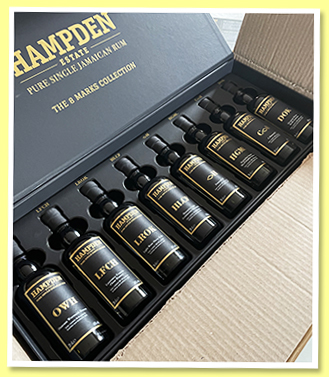 |
I'd add that this is one of rum's advantages w.r.t whisky, you can have rum white, while you can't quite have whisky white (except that Glen Kella from the olden days). Globally, rum's more about the distillate, although more and more rum makers are starting to talk about wood and wine a little too much for my taste. We'll see what happens in the coming years, I for one wouldn't mimic whisky too much… |
So, first up, those eight new white Hampdens, sorted by 'ascending' marks, meaning by growing proportions of esters in the new distillate. What's also brilliant is that they would tell you what those marks really mean, with many technical details… Oh and the fact that they would have bottled all eight at the same strength, 60% vol. while they were all distilled in some of their six (some say four) double-retort pot stills. Dazzling from the beginning to the end! (Hope I'm not sounding like a brochure…) |
Hampden 'OWH' (60%, OB, La Maison & Velier, The 8 Marks Collection, 20cl, 2022) 
The mark means 'Outram Wormald Hussey' while the level of esters is of 40 – 80 gr/HLPA (hectolitre pure alcohol). OWH is the lightest mark and was created very recently, in the early 2010s. There is no cane juice vinegar (a concept new to me, I would suppose that's all about bacteria), no dunder and no muck added to the molasses. Colour: white. Nose: that's the thing, it's a bit like peat, even when there's very little you call it 'smoky' or, in this case, 'estery' (or, there, funky). I'd swear there's some Diesel oil, olive oil, capers, lemon syrup… But if I want to survive this session, I'd better bring them down to approx. 45% vol. as soon as possible. So, with Vittel water: it's the mineral side that stands out, chalks and concrete dust, new magazines, ink, linseed oil, and simply fresh crushed cane juice. Mouth (neat and quickly): excellent lemon juice, olives, capers, citronella and a little soap, which is perfectly normal at this point, in my opinion. With water: indeed, it's already in high-esters territories, this time with more saltiness, oysters, and those lemons and olives. Imagine you would think whisky and peat levels, let's say we're already in Ardmore's ballpark. I have no idea if you have stories about bacteria and yeasts colonising distilleries and imposing their marks on any output, as would happen in wine (like in Jura for example)… No soapiness left. |
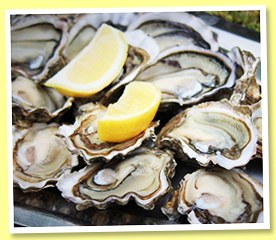 |
Finish: long and saltier, clearly coastal. I find it terrific, and this is only the start. Rotting bananas in the aftertaste. Comments: what it didn't quite have was ammonia, acetone, heavy varnishes and all that. Love this already, boy is this going to get tough…
SGP:562 - 90 points.
(Picture, oysters from the Île de Ré, Destination Île de Ré.) |
Hampden 'LFCH' (60%, OB, La Maison & Velier, The 8 Marks Collection, 20cl, 2022) 
That's 'Lawrence Francis Close Hussey', while the esters would range from 80 to 120 gr/HLPA. It is also a newer mark, it's all also done with molasses without the addition of any vinegar, dunder or muck, but with a longer fermentation period, 4 days instead of 3 for the OWH. I'm not sure you could say that simply adding 33% fermentation time doubles the esters, could you? It's also to be noted that the wash is at a higher strength for both lighter marks, that is to say 5% A.B.V. instead of 2-4% in all more estery ones to come. I find it really cool that they would give us all these data. Colour: white. Nose: there, trouble begins. I mean, so far I'm finding it rather less estery, and a bit more on caraway-and-curry-like spices. But then again, no chances to be taken… With water: more vegetal notes this time, rather around ferns, but the core remains all on chalky lemons, with some ink, paraffin, probably a little glue… |
Mouth (neat): more brutal than the AWH this time, with some varnish, but… With water: some fresh fruits, tangerines, maracuja, more lemons, and our petroly olives. Finish: really long, not vastly different from the OWH. Comments: it really takes immense amounts of water before starting to fall to pieces. I love it, but OWH remains my favourite. But this is only the start…
SGP:652 - 87 points.
(Picture, Marmiton) |
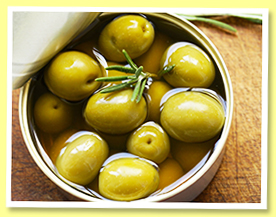 |
Hampden 'LROK' (60%, OB, La Maison & Velier, The 8 Marks Collection, 20cl, 2022) 
LROK means 'Light Rum Owen Kelly', the proportions of esters in the make being of 200-400 gr/HLPA. That's clearly not 'light', is it. It is an old mark from the late 19th century this time, the Owen-Kelly family used to be the owners of the Distillery at that time. To make this one there was an addition of cane vinegar, dunder and muck to the molasses, but in low proportions. By the way, I need to confess that until this very day, I used to believe that dunder and muck were kind of the two sides of the same medal. Shame on me. Anyway, this time they've done an acetic fermentation following the alcoholic one, which brings the total time to five days. Colour: white. Nose: glues and rotting fruits are chiming in this time, while there would be more citrus as well, especially lime. A kind of smokiness too, or am I dreaming? With water: it's getting dirtier than the others, fatter, with many oils, putties, and paints. Like olive green, no need to say (please stay focussed, S.) Mouth (neat): fabulous pure Hampdenness, with more olives than ever, zests, petrol (a feeling of…) and spent oils (something reminiscent of…) With water: a clear favourite, not a throwaway, limoncello and fruity olive oil, chalky chardonnay, some tar showing up for the first time… |
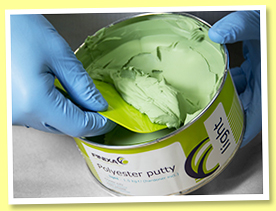 |
Finish: long, chiselled, salty, olive-y and lemony. Tar and petrol in the aftertaste. Comments: this is Hampden as we know it. As for it being white, I'm starting to believe that with the best rums (cane juice and /or pot still), aging is just an option, or a variant. Glorious.
SGP:662 - 91 points.
(Picture, Polyester putty, Finixa) |
Hampden 'HLCF' (60%, OB, La Maison & Velier, The 8 Marks Collection, 20cl, 2022) 
HLCF stands for 'Hampden Light Continental Flavoured' while the amounts of esters are reaching the 400-600 gr/HLPA threshold. To think that someone, a long time ago, has been considering this as 'light'… I would suppose that it was designed as a dresser for continental brands, and that 'flavoured' rather meant 'flavourful'. No? Colour: white. Nose: I see, some turpentine appearing this time, acetone indeed, nail polish remover, also always a lot of chalk and clay, the usual olives, some tiny pickled citrus… With water: forgot to say, it was still harbouring low amounts of vinegar, dunder and muck, while the fermentation time was extended to 7 days. As for this nose, once water's been added it's really going to the other side, the side of glues, paints and varnishes. |
Mouth (neat): totally massive already. Black olives this time, glues, lime, varnishes, tar, black propolis, many rotting fruits… With water: wow, brilliant. Fresh lemons and oysters on top of all those tarred olives and clearly overripe bananas and pineapples. Finish: very long, estery, tarry, even slightly rubbery. Turpentine and peat (you read that right) in the aftertaste. Comments: what's really cool with all these Hampdens is that you can taste many elements that, in real life, you would never, ever put into your mouth. Such as turpentine… Fab rum, who needs oak…
SGP:563 - 92 points.
(Picture, OneHOWTO) |
 |
It's now that it's becoming a little scary… |
Hampden '<>H' (60%, OB, La Maison & Velier, The 8 Marks Collection, 20cl, 2022) 
'<>H' a.k.a. 'diamond H', 900-1000 gr/HLPA esters, medium amounts of cane juice vinegar, dunder and muck, 3 days alcoholic fermentation + 7 days secondary acetic fermentation (dead wash), with high acetate ethyl (5.5%) and close to 90% butyrate. Knowledge is power! Let's see how all those dazzling data will translate… Colour: white. Nose: we're at a gas station rather than at a Distillery now, but it is still kind of balanced, with bananas and guavas still there in the background. Whacky guavas are particularly obvious, in my opinion. But remember, no chances taken… With water: more fern, vinegars indeed, olives in abundance, tar, seawater, engine oil… The oysters have become severely fat. Mouth (neat): more paint and certainly a lot of acetone. Also huge quantities of liquorice this time, which wasn't obvious in the others. This baby is particularly strong, I have to add. With water: we've clearly reached extreme territories, says this whisky enthusiast. Varnish, dust, Diesel oil, capers and gherkins, green lemons (rather than lime), nail polish, acetone… |
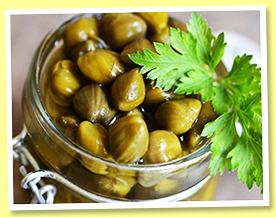 |
Finish: extremely long, with some strawberries at first, which you could sometimes find in heavily peated whiskies too, then just a lot of salty oils, tar, and 50 kilos of cracked olives in the aftertaste. Comments: utterly wonderful, but I would say we start to lose a little balance. The HLCF was ahead of it, in my humble little book.
SGP:463 - 90 points.
(Picture, capers, Gastronomiac) |
Hampden 'HGML' (60%, OB, La Maison & Velier, The 8 Marks Collection, 20cl, 2022) 
HGML stands for 'Hampden George MacFarquhar Lawson', a mark originally for blending for export markets. High cane vinegar and medium dunder and muck proportions, while the fermentation times reach 15 days (5 alcoholic, 10 acetic). The proportions of esters are reaching 1000-1100 gr/HLPA. Colour: white. Moves like oil your glass. Nose: grasses and glue, would I say, but there also more fresh fruits this time, which we weren't expecting. Even pears and pineapples, and certainly something eau-de-vie-ish (kirschwasser, plums). Some earth as well. This one's intriguing, perhaps thanks to some clearly longer fermentations. With water: fumes and cigarette smoke at first, then dark chocolate and even some coffee. Varnishes, olives and lemon juice are joining only later on. Mouth (neat): heavy glues and acetone, plus crushed bananas and rhubarb wine, and really a lot of liquorice. It remains bright, having said that. With water: higher salinity, but also more sweetness, even notes of yoghurt. Preserved cherries, really? This one's really unusual, or at least different. |
Finish: long and, this time, unexpectedly rooty. Beets (which takes the cake) and gentian spirit. The aftertaste is more acetic and varnishy, as expected this time. Some heavy liquorice and pepper too. Comments: highest order, naturally, but a 'funnier' one.
SGP:563 – 88 points.
(Picture, preserved cherries, Les Gourmandes Astucieuses) |
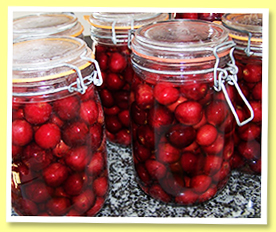 |
Hampden 'C<>H' (60%, OB, La Maison & Velier, The 8 Marks Collection, 20cl, 2022) 
So 'C Diamond H', which I don't think I've ever seen before, with high cane juice vinegar, muck and dunder adjunctions, very long fermentations (10+10=20 days), and 1300-1400 gr esters/HLPA. Scary résumé, don't you think? Colour: white. Nose: back to concrete and diesel oil, pickled gherkins, olives, carbon dust, old brake pads, plus new electronics and leatherette. No fruits in sight this time, so far. With water: it is much more elegant than I would have thought, rather less wham-bam-check-my-esters (S., are you all right?) and rather on various herbs and earths. Something basaltic. Mouth (neat): really extreme this time. Concentrated lemon juice, acetone, indeed vinegar, some very tight liquorice, the greenest green olives… With water: perfect, straight to the point, no detour ahead (sweet Bill Evans!), rather on some earthy liquorice and, to be honest, not that much acetone. And a lot of olives, aren't they throwing olives into the pits? |
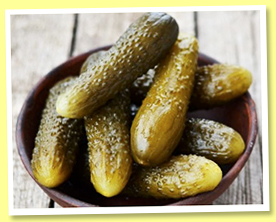 |
Finish: long, rather elementary, in the best sense of that word, simple, perfect. Olives, lemon, salt and tar. What does the people want? Tight 'green' white wine in the aftertaste. Comments: awesome, one that you could actually sip without racking your brains.
SGP:552 - 90 points.
(Picture, gherkins, NDTV Food) |
What's complicated is that I love Hampden, so in no b****y way could I proceed by elimination. Anyway, the last one will be a legendary… |
Hampden 'DOK' (60%, OB, La Maison & Velier, The 8 Marks Collection, 20cl, 2022) 
DOK stands for 'Dermot Owen Kelly-Lawson', the highest ester count at Hampden and in Jamaica in a whole, with 1500-1600 grams esters per hectolitre pure alcohol, which is the legal limit. Fermentation was eternal (well, 10 days alcoholic + 15 days acetic) while they had originally added the highest proportions of cane vinegar, muck and dunder. It is not the first DOK we're trying, but let's remember that esters may translate differently in any aged rums. Yeah, t's like peat, nothing is linear or granted. Colour: white wine. Nose: the fumes from a well-tuned old 911, geraniums, tomatoes, williams pears, young Comté cheese, vinyl, sour cherries… Well, the molecules in there seem to be run off their feet! With water: grass, cactus, carbon, slate, capers, samphires, and this vinyl again. A large box full of old 33 rpm vinyls and cassettes. A little ammonia this time, and more cheese as a consequence (or conversely). Mouth (neat): yes, no, I don't know. It is full of varnish and cigar ashes. I love it and I hate it, pretty intermittently. Only escape, water: it's gherkin juice with some cellulosic varnish, kept in an amphora with bits of tyres and green olives. Quite bizarrely, this works. |
Finish: extremely long, with lemons back at the helm. Smoked olives and tarry ashes in the aftertaste. Even a little vanilla and sweet oak which, I agree, cannot be there. Sweet mustard. Comments: fantastic, if a little tiring at times. Between us, would you have more than three glasses of this? A theoretical question…
SGP:653 - 90 points.
(Picture, Porsche 911t 1970, Richard Opie) |
 |
Announcing The Podium
What's my favourite mark/marque? Well, they may then age differently depending on their profiles, the various precursors that they may shelter and all that, but as far as white Hampdens are concerned, my personal podium would be:
- HLCF
- LROK
- OWH, <>H, C<>H, DOK
Disagreements and taunts: on a postcard please. |
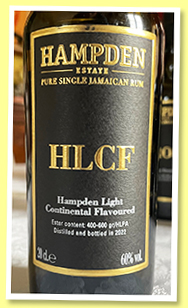 |
Good, I feel like I should pinch myself to see if I'm still alive after these crazy eight Hampdens. It seems that I am, so what did we learn? First, that they're all superlative. No real surprises, but there. Second, that these rums do not really need oak. In a way, they're like the greatest mezcals. Third, that ester counts aren't linear by any means, at least not 'in your glass', possibly because of our own detection thresholds or personal biases and distortions. Fourth, that fermentation times, whether alcoholic or bacterial, are extremely important. And fifth, and rather deceptively, that some rum makers are now at the cutting edge in terms of education and engagement, while so many whisky makers are still busy doing some lousy 20th century-type brand-building that would make the most optimistic oyster cry. But didn't we say we'd also try a few aged Hampdens? I think we've got a pretty young one, for example… |
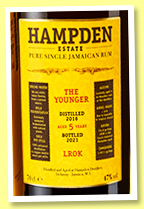
|
Hampden 5 yo 2016/2021 'LROK the Younger' (47%, OB) 
A little Wedderburn sheltering 314.8 gr esters per HLPA. Long live precision! This should go down easy and effortlessly. Colour: white wine. Nose: citrons running the show, together with light varnishes and green pears. Some American oak has added some roundness, some vanilla, and some fresh ripe bananas, plus a feeling of cane juice, rather agricole-style. This is smoother and rounder than any of the whites from the Collection, from the OWH up to the crazy DOK. Mouth: much Hampdenness at first (varnish and olives) but once again, the sweet American oak made it almost cakey, almost as if someone had added some maple syrup. Now, lemons are coming to the recuse, re-establishing balance and zestiness. A little saltiness finishes the job. Finish: medium to long, very citrusy, and actually just excellent. I think we got a little bit spooked over nothing. Comments: super mega good, easy for Hampden. Just like with Pliny, the Younger can match the Elder; now you do feel, at times, that the oak was not that necessary. I know some true rum afficionados that would always, ever favour the whites.
SGP:652 - 87 points. |
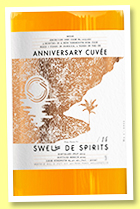
|
HPDN 2013 '<>H' (65.4%, Swell de Spirits, Anniversary Cuvée, cask #05086) 
A rather pan-Jamaican baby, as it was first matured on location at HPDN for 7 years, then for 2 years in the UK, then for 3 months in a New Yarmouth cask, which sounds a little.. odd. But they say only the result counts… By the way, remember, <>H means heavy butyrate, so ripe bananas and pineapples. And 900-1000 gr esters/HLPA altogether. Colour: light gold. Nose: crazy indeed, very vinegary, with shallots and onions, olives, tar, caramel and many varnishes and ketones. Mirabelle plums and bananas are kicking in after a moment and would literally invade it. With water: unknown aromas. It is very intriguing, with something Chinese as far as the profile's concerned. Chen-pi, Austrian riesling, young vinegar de Jerez, sweet Chinese sauces indeed, also raisins (raisins?!) Mouth (neat): extremely powerful. Crunching raw rhubarb and the greenest green plums. But that should be temporary… With water: acetone and varnish at the helm, tar and brine on the deck, olives and pineapple liqueur in the bilge. Moreover, it swims extremely well and can take a lot of water. Finish: long, rounder, but always salty, varnishy and olive-y. I haven't quite got New Yarmouth's profile in mind, but it may be the guilty party. Comments: very crazy indeed, with esters moving in a Brownian way, not easy to follow but rather spectacular.
SGP:562 - 89 points. |
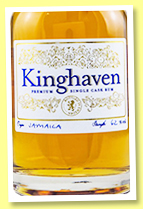
|
Hampden 15 yo 'C<>H' (62%, Kinghaven, sherry finish, 2022) 
Kinghaven is a brand by Smögen, the small albeit very valiant Swedish Distillery. If they have decided to finish some Hampden in sherry, there must have been a reason, beyond the fact that they were having some empty sherry cask at hand. Oh and remember what we've learnt, C diamond H means extremely high esters… Colour: gold. Nose: right, the sherry was anecdotal, or was it some manzanilla? What it's got is rather some camphor and pine resins, beyond the smoky and tarry olives and all the crazy varnishes. With water: massive oliveness. It's all about olives, really, with an acetic side. But now that we've learnt that they're adding some cane juice vinegar to the molasses, nothing surprises me anymore. Great nose. Mouth (neat): well, smoked olives perhaps? Surely some high-concentration tarry grassiness, crushed olives, stone dusts, ashes, vinegars, green walnuts, some mad nocino liqueur… With water: pure high-ester Hampden, with just a piney side. A piney side from a sherry cask? Why not! Finish: very long, a tad waxier and with some lemon marmalade. Really. Comments: pretty experimental, with emphasis on the 'mental' part of that word. A joyous, rather extreme concoction by Smögen, top rung for sure but it's like mortadella, we don't actually wanna know how they made it. Remember these are the folks who are also making surströmming (okay, I owe you a beer, Pär).
SGP:563 - 89 points. |
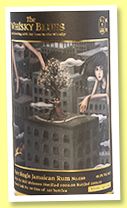
|
Jamaican Rum 21 yo 2000/2022 'JMLR' (48.2%, The Whisky Blues and Get Lost In The Whisky, cask #94, 137 bottles) 
Brokers are using different marks, in this case it seems that JMLR is a mark by E & A Scheer in Amsterdam and would translate into LROK. For example, Cadenhead's are using the mark JMLR for Hampden LROK, which, remember, is a lighter mark, with 200-400 gr esters/HLPA. We'll also remember that it's not all linear anyway… Colour: straw. Nose: this is so gentle, easy, rather on sunflower oil, green tea, soft sweeter olive oil rather than plain olives, old books, spearmint, with a little myrtle and elderberries, whiffs of pine smoke, lime tea, wormwood… In truth I'm finding this fantastic, extremely subtle and delicate. Mouth: absolutely wonderful, starting with various citrus and mints, herbs of many kinds, a dollop of fir honeydew, then we'd find the olives that are actually running today's show, then sour wines, lemon juice, dill, even smoked kippers… We're actually slowly moving towards old Islay, especially towards the briniest Bowmores. And oysters! Finish: medium to long, very maritime. Oysters in majesty, with smoked olives as the garniture. The aftertaste would be a notch sweeter, perhaps on raisins, perhaps on goji berries. Comments: wow. There was also a medicinal side, but all in all, it was truly as maritime as a… stripped-back Bowmore.
SGP:562 - 91 points. |
 Check the index of all rums we've tasted so far Check the index of all rums we've tasted so far
|
|
|
| |
|
|
|
|
|
|

